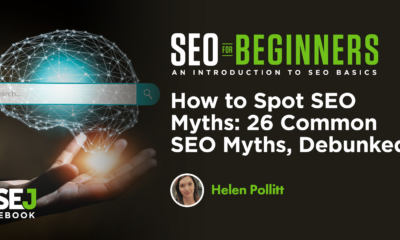MARKETING
6 TikTok Myths, Debunked in 2022

Many marketers have flirted with the idea of trying TikTok, but certain misconceptions have stood in the way.
For instance, isn’t it just a platform for teens? Specifically, teens who lip-sync?
To help curb the confusion, we’ve rounded up a list of common TikTok myths to help you decide whether it deserves a spot on your marking roster. Let’s dive in.
6 TikTok Myths, Debunked in 2022
- TikTok’s audience is too young.
- TikTok is just for lip-synching and dancing.
- If your brand is ‘serious,’ TikTok isn’t for you.
- You need a lot of followers to go viral.
- Because TikTok videos are shorter, users are less engaged.
- TikTok is a fad.
Myth 1: TikTok’s audience is too young.
Brands mistakenly assume that TikTok is just for teens and young adults. Although it initially exploded in popularity with the Gen Z crowd, TikTok is quickly “growing up.” In fact, 36% of TikTok users in 2021 were between 35 and 54 years old, a 10% increase from the year before.
On top of that, 50% of Millennials report visiting TikTok in the last three months, along with 38% of Gen X-ers, according to HubSpot’s 2022 Consumers Trends Report. We predict these numbers will continue to rise as TikTok cements itself as a mainstream social platform.
Myth 2: TikTok is just for lip-synching and dancing.
While these types of videos certainly exist on TikTok, it’s only the tip of the iceberg. As its audience has grown more diverse, so too has its content.
Nowadays, you can find videos that hit almost any niche. For example, some of the most popular TikTok categories include cooking recipes, beauty tutorials, fitness routines, life hacks, and even pet videos. This also means TikTok can work for a variety of brands across different industries.
For example, Ryanair, a European airline, is a fan favorite on TikTok with almost two million TikTok followers. DuoLingo, a language learning app, is another favorite with over four million followers. Then there’s Red Bull, a popular energy drink, with almost 7 million followers. These are wildly different brands, from different industries, that have built a healthy audience on TikTok.
Curious which brands are winning on TikTok? Check out this helpful guide to get inspired.
Myth 3: If your brand is “serious,” TikTok isn’t for you.
TikTok has a reputation for being quirky — but if your brand is on the serious side, don’t let this scare you away. Instead, try approaching your brand from a different angle.
For example, take a look at Planet Money, an NPR-backed podcast that covers complex topics about the economy. Not the most entertaining topic in the world, right? Yet, it’s raked up almost 750,000 followers.
From gentrification to mortgages, no topic is too serious for Planet Money to tackle with a humorous spin. Need convincing? Take a look at the following video that asks, “Is free shipping really free?”
If you feel your brand is too “serious” for TikTok, take a note from Planet Money and approach your brand — and the content you create — from a different lens. At the end of the day, it’s about sharing value and delivering it in an engaging way — and that’s a goal almost any brand can attain.
Myth 4: You need a lot of followers to go viral.
On TikTok, anyone can go viral. Even accounts with a handful of followers can spark millions of views on a great video.
Its viral nature is a direct result of its algorithm. How does it work? The algorithm pinpoints users that may enjoy your content based on their previous watch history, hashtag searches, and current location. Then, it will push your video to their feed. If enough people engage with it, the algorithm will share it to even more people. Next thing you know, you have a viral hit.
Here’s an example: suppose you post a video of yourself hiking a mountain. The algorithm shows your video to users who live nearby, as well as those who recently searched for hiking trails on the platform. It notices a lot of people “liking” and commenting on the video, so it shares it to more users.
Long story short, if you’re worried you won’t get any traction on TikTok, it’s helpful to remember that the algorithm is on your side, enabling you to reach more people outside of your immediate followers.
Myth 5: Because TikTok videos are shorter, users are less engaged.
TikTok is known for its short, bite-sized content. However, this creates an illusion that users don’t spend much time on the platform.
Fortunately, this couldn’t be farther from the truth. In fact, TikTok has an average user session of 10.85 minutes, far exceeding any other social media platform. On top of that, users in the U.S. open the TikTok app 8 times a day on average.
Myth 6: TikTok is a fad.
Will TikTok meet the same fate as Myspace and Tumblr? While it’s too early to call, I’d argue that it doesn’t really matter.
For one, short-form video is dominating the social media landscape. If TikTok meets its demise, consumers will still crave this content. The audience may jump to a new platform, or migrate to an existing one. Either way, you still need to know how to create engaging, snackable content — and TikTok is the leading platform to hone this skill.
Second, if you build your brand correctly, no rise or fall of a single platform will topple it. If you build a strong community around your brand, it will become unshakeable. But in order to do this, you need to go where your audience is — and, for right now, that might be TikTok.
Back To You
Let’s end with one final myth: it’s too late to join TikTok.
This is untrue, especially if your audience is active there. Further, its high engagement rates, stellar growth potential, and powerful algorithm can take your digital marketing to the next level. That said, time is of the essence. Brands that establish a presence on TikTok now can stay ahead of the curve.

![6 TikTok Myths, Debunked in 2022 Free Ebook: The Marketer's Guide to TikTok for Business [Download Now]](https://articles.entireweb.com/wp-content/uploads/2022/03/TikTok-Trends-B2B-and-B2C-Marketers-Should-Watch-in-2022.png)

















You must be logged in to post a comment Login